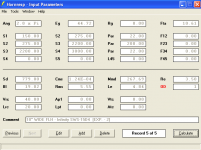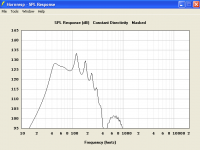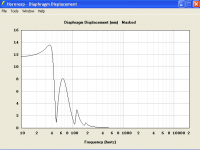What was the Xmax of the previous drivers?
Published Xmax for them is 12mm. From observation, it looks like the suspension brings the cone to halt not much longer after that.

^^^ This pic says a lot. You can see the Alpine's 70mm of xmech is no joke. I see a lot of car audio drivers where they slap a huge surround on a woofer to give the impression that it has a lot of xmax, but then you flip it over and the woofer is 5" deep. The Alpine Type R eights are nearly as deep as they are wide.
The driver pictured next to the Alpine 12D2 is the Infinity 122.7W. That's what I used previously in my car. Interesting driver, but not a match for the 12D2s. t/s parameters suggest that it's a better fit for a sealed cab at home (F3 around 30 Hz), but did reasonably well in-car. The suspension suggests it might be a better fit for a vented alignment (which is what I'll be trying them in next, in-house). Neo magnet motor (most of what you're seeing in the picture is the heat-sink for the motor), 3" voice coil and 350W RMS, 1.4kW peak rating. I got them for about $100 each.
http://support.alpine-usa.com/products/documents/OM_SWS-101215_D4_2.pdf
IMHO, those Alpines are tough to beat. Even at $200-$300 each, they offer features that the Lab12 doesn't have. A flat BL curve and higher displacement. The higher FS is very useful for a tapped horn, as the bandwidth of a TH is highly influenced by the FS of the driver. Basically a driver with an FS of 22hz tends to work well in a sub-20hz TH, and that's often more sub-bass than you need for music.
SWS-15D4 : $129 delivered(!)
Also Mr. Bateman, in post #50 of http://www.diyaudio.com/forums/subwoofers/250573-alpine-sws-15d2-tapped-horn-5.html#post3811990 you also commented on the Alpine 15", saying:
One thing that I'm exploring is whether front loaded horns have more 'impact' than THs and BLHs. I've read this on forums, so I'm building a FLH with a TC Sounds eight to find out. The Alpine 15" would make a great candidate for a big FLH. In fact, it's probably better suited for a FLH than a TH, unless you need ultra low LFE (which you might, depends on application.)
When I first started experimenting with Hornresp, I found it amusing to substitute different drivers in existing designs to see how well they worked. I had tried a lot of the Alpine and Infinity "auto sound" subwoofers, and got some funky response curves - which I now realize that the designs I substituted them into were really optimized for a higher Fs driver.
But your comment above that the Alpine 15" may be better suited for a FLH instead of a TH spurred me to try a new idea over the weekend. Go ahead and laugh, but here is my first attempt at a FLH. I didn't put a lot of thought into it, just played around with the "Loudspeaker Wizard" until I got something that didn't look too ugly. I would appreciate you thoughts on this. Thanks.
Attachments
Also Mr. Bateman, in post #50 of http://www.diyaudio.com/forums/subwoofers/250573-alpine-sws-15d2-tapped-horn-5.html#post3811990 you also commented on the Alpine 15", saying:
When I first started experimenting with Hornresp, I found it amusing to substitute different drivers in existing designs to see how well they worked. I had tried a lot of the Alpine and Infinity "auto sound" subwoofers, and got some funky response curves - which I now realize that the designs I substituted them into were really optimized for a higher Fs driver.
But your comment above that the Alpine 15" may be better suited for a FLH instead of a TH spurred me to try a new idea over the weekend. Go ahead and laugh, but here is my first attempt at a FLH. I didn't put a lot of thought into it, just played around with the "Loudspeaker Wizard" until I got something that didn't look too ugly. I would appreciate you thoughts on this. Thanks.
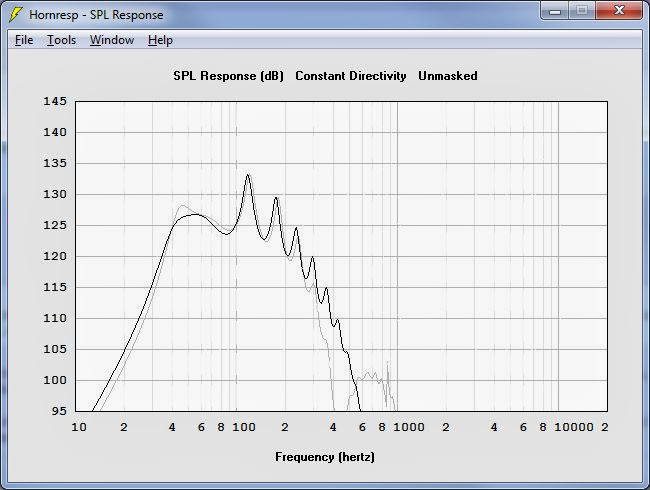
Fifteens need a big box; so using the same parameters there wasn't a whole lot I could do. But on the upside you can't do a lot better in this footprint!
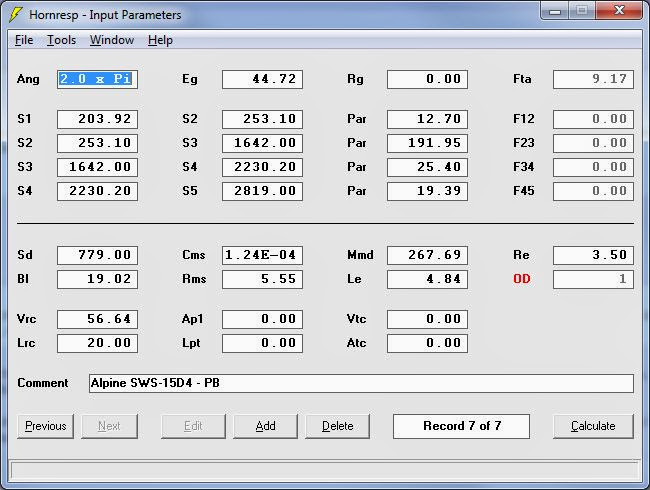
Enlarging the back chamber extends the low bass a bit, reduces that low frequency peak, but at the expense of a bit higher displacement. But with a highpass at 30hz you won't hit it excursion limits. Without a highpass you'll exceed them by a single millimeter, which probably won't do anything to a driver with an xmech of 70mm.
Move the highpass to 40hz and you could probably double the power handling.
DHAA, you want the response shape of a FLH to slope the other direction generally, because FLHs exhibit a unique trait, when you add more cabs to the stack (or wall/corner load) the low frequency droop is "filled in".
Heres my take on the driver keeping with the 340 liter parameter. as you can see in the picture, it will take about 60v before exceeding xmax (35hz filter for 1 cab, 30hz filter for 4 or more cabs). I've shown the response for 1 cab (standard FLH "rising response" as freq increases), and 8 cabs (pretty darn flat)
The Alpine seems to like a lower compression ratio (helps fill in the 70 to 100 range).
this is a quick 10 min sim.
however, givin 340 liters, you can get within a db of this sim with the lab12 driver with 300 watts per box (45volts) (vs the almost 1000 per box the alpine will take)
Heres my take on the driver keeping with the 340 liter parameter. as you can see in the picture, it will take about 60v before exceeding xmax (35hz filter for 1 cab, 30hz filter for 4 or more cabs). I've shown the response for 1 cab (standard FLH "rising response" as freq increases), and 8 cabs (pretty darn flat)
The Alpine seems to like a lower compression ratio (helps fill in the 70 to 100 range).
this is a quick 10 min sim.
however, givin 340 liters, you can get within a db of this sim with the lab12 driver with 300 watts per box (45volts) (vs the almost 1000 per box the alpine will take)
Attachments
Last edited:
Thanks Mr. Bateman and Mr. 143 for you comments - they were very helpful.
How can you tell that - is there a particular TS spec. you are looking at? Thanks.
The Alpine seems to like a lower compression ratio (helps fill in the 70 to 100 range).
How can you tell that - is there a particular TS spec. you are looking at? Thanks.
Originally Posted by sine143
The Alpine seems to like a lower compression ratio (helps fill in the 70 to 100 range).
The Alpine seems to like a lower compression ratio (helps fill in the 70 to 100 range).
You can tell by comparison-sine143's sim using a lower compression ratio than Bateman's (or yours) has a smoother response in the 70-100 Hz range, but a slight reduction in the low frequency.How can you tell that - is there a particular TS spec. you are looking at?
Last edited:
Yeah, pretty much just trial and error. with a higher compression ratio it was basically impossible to fill in that gap in the 70 to 100 range, and as you saw, it required a slightly larger rear chamber (as per PBs sim). with a lower compression ratio and a slightly smaller rear chamber I was able to fill that section in (significantly I might add) and only sacrifice about a db of sensitivity down low (Which is compensated for as soon as you add multiple cabs, considering the mouth on my horn is larger than those on yours or patricks).
Guys,
Seems like most of your discussion here have evolve around either car or PA applications. I have a pair of Lab 12's and am curious about using them in small enclosure, push pull configuration. I've looked around a bit and haven't found anything specifically addressing this approach. Any thread suggestions or insights would be appreciated.
Thank you.
Seems like most of your discussion here have evolve around either car or PA applications. I have a pair of Lab 12's and am curious about using them in small enclosure, push pull configuration. I've looked around a bit and haven't found anything specifically addressing this approach. Any thread suggestions or insights would be appreciated.
Thank you.
Hey, Cold Lefty,I have a pair of Lab 12's and am curious about using them in small enclosure, push pull configuration. .
Here is a comparison using Lab 12s in push pull configuration and normal, sealed and ported:
http://www.diyaudio.com/forums/subwoofers/191833-push-pull-vs-normal-distortion-compared.html
Art
How can you tell that - is there a particular TS spec. you are looking at? Thanks.
Throat area [St] is a compromise between the driver's motor strength [Qes] Vs a speaker's desired HF corner [Fhc] and the driver's compliance [Vas], which few folks adhere to except by coincidence, so in theory won't perform optimally no matter how closely its measurements mirror the sim.
In comparing folk's measurements to the sims though, it became obvious that a TH tends to 'bend' a driver's specs to its 'will' even more so than a FLH, so in its own way seems as 'forgiving' of a specs misalignment as a sealed one and much more so with increasing power.
From this I concluded that for HIFI/HT apps we probably should be designing based on desired mean applied power rather than max power [SPL], which can significantly reduce net cab Vb, allowing smaller/cheaper driver multiple subs for more optimal placement and/or better WAF for those afflicted.
GM
Hi Art,
I put on my super power (super hero) spectacles and took a look at the charts on your referenced thread. A substantial body of work thank you for pointing me in that direction. It was quite helpful in understanding more about comparable distortion levels. Interesting listening observations, not sure what to make of that.
I keep bumping into vastly different pros and cons with this approach. Some saying it’s a waste of a driver others saying it’s the best combination they’ve heard. Thinking I'll take my chances on a rough prototype first, then leave it up to mike and my ears.
It seems like there are as many PP types as opinions. I’d like to try this design with the goal of eliminating, or significantly reducing enclosure vibrations. With all these approaches, are you aware of any threads focused of vibration reduction?
Thank you,
Mark
I put on my super power (super hero) spectacles and took a look at the charts on your referenced thread. A substantial body of work thank you for pointing me in that direction. It was quite helpful in understanding more about comparable distortion levels. Interesting listening observations, not sure what to make of that.
I keep bumping into vastly different pros and cons with this approach. Some saying it’s a waste of a driver others saying it’s the best combination they’ve heard. Thinking I'll take my chances on a rough prototype first, then leave it up to mike and my ears.
It seems like there are as many PP types as opinions. I’d like to try this design with the goal of eliminating, or significantly reducing enclosure vibrations. With all these approaches, are you aware of any threads focused of vibration reduction?
Thank you,
Mark
Mark,It seems like there are as many PP types as opinions. I’d like to try this design with the goal of eliminating, or significantly reducing enclosure vibrations. With all these approaches, are you aware of any threads focused of vibration reduction?
Opposed speakers, whether push push or push pull (one driver reversed polarity) will eliminate forward and back cabinet rocking, which makes cabinets "walk", and makes large baffles "flop".
There seems to be more concern about panel flop when using woofers on a wall or ceiling as an infinite baffle, plenum loading eliminates the problem of making the wall itself shake. There is more discussion on AVS about that sort of thing.
Art
Thank you very much for accepting!The Eminence Lab12 has proven itself worthy in a variety of low-tuned PA applications. This venerable driver has held up well and is still a good candidate for many types subwoofer designs.
The Lab12 has been been around for a while and had been used in bass reflex, tapped horn, and front loaded horn alignments, so I propose a shoot-out of some of these Lab12 designs. Let's not get nasty. What is ideal for one person might not work for another, so please keep an open mind.
One of DIYaudio.com's elder statesmen, weltersys, has two proven designs that I submit for the first-round smack down.
In one corner we have the weltersys Keystone Sub, a tapped horn that is very adaptable:
http://www.diyaudio.com/forums/subwoofers/185588-keystone-sub-using-18-15-12-inch-speakers.html
They Keystone Sub este un tip mare (45" înălțime x 26,5" lățime x 22,5" adâncime), dar încărcat cu două Lab12-uri merge joasă și tare. Aceasta este cursa gri din graficul de mai jos.
În celălalt colț avem designul bass reflex weltersys Dual Lab12 :
SUBPLAN GRATUIT: Dual Lab12 (încărcat frontal) de la Welter Systems
Dual Lab12 este un tip micuț (22,5" înălțime x 26,5" lățime x 22,5" adâncime) - jumătate din dimensiunea Keystone Sub. Merge la fel de jos ca Keystone, dar nu la fel de tare. Aceasta este urma albastră de pe graficul de mai jos.
It is a plan tuned to 35hz created for PRO AUDIO applications with GOOD EXTENSION, and a better load on the speakers in the peak impedance given by the enclosure, that is why the port is flared at the ends and narrowed in the middle. I recommend it with confidence because it sits very strong and deep with very good extension.
Aici atașez un clip cu niște măsurători.
Am măsurat cu un microfon RTA SPL LAB PRO.
Deci, dacă ai avea nevoie de un subwoofer care să fie foarte scăzut și să se încarce, pe care dintre aceste modele ai construi și DE CE? Care sunt avantajele/dezavantajele pe care le vedeți la fiecare design.
Să păstrăm lucrurile civile. Personal cred că acestea sunt ambele modele excelente - unul dintre cele mai mari argumente ale mele ar fi dimensiunea și portabilitatea.
Here you have a clip with measurements in the 35-60 hz band, the margin of error is 10 dB, because I measured with another sensor in the software, I don't know why it went like that, from the obtained value, subtract 10 and get the continuous spl.Thank you very much for accepting!
View attachment 1121118 View attachment 1121119 View attachment 1121120 View attachment 1121121 View attachment 1121122 View attachment 1121123 I'm opening this thread to introduce my double LAB 12.
It is a plan tuned to 35hz created for PRO AUDIO applications with GOOD EXTENSION, and a better load on the speakers in the peak impedance given by the enclosure, that is why the port is flared at the ends and narrowed in the middle. I recommend it with confidence because it sits very strong and deep with very good extension.
Aici atașez un clip cu niște măsurători.
Am măsurat cu un microfon RTA SPL LAB PRO. View attachment 1121124
Amplification was crown xls 1502:
2x775 w rms 2 ohms
2x525 w rms 4 ohms
2x300 w rms 8 ohms
I had about 517 w rms in 3 ohms. The signal on the crown was about -20 dB, giving the gain from the mixer until around 11 o'clock because of the usb mp3 player which has a very bad signal and I had to increase the gain from the mixer to get those values.
That's a pretty neat-looking design. I don't often see vented designs with butterfly / rocket ports here, even though that type of vent is supposed to produce great results at higher power levels. The frequency response curve - is that predicted or actual? Looks like it might have been generated in Hornresp...
Yes, in horn response, the sensitivity is in a quarter of the space at 2w/mThat's a pretty neat-looking design. I don't often see vented designs with butterfly / rocket ports here, even though that type of vent is supposed to produce great results at higher power levels. The frequency response curve - is that predicted or actual? Looks like it might have been generated in Hornresp...
- Home
- Loudspeakers
- Subwoofers
- The Lab12 PA Subwoofer Smack Down/Death Match
